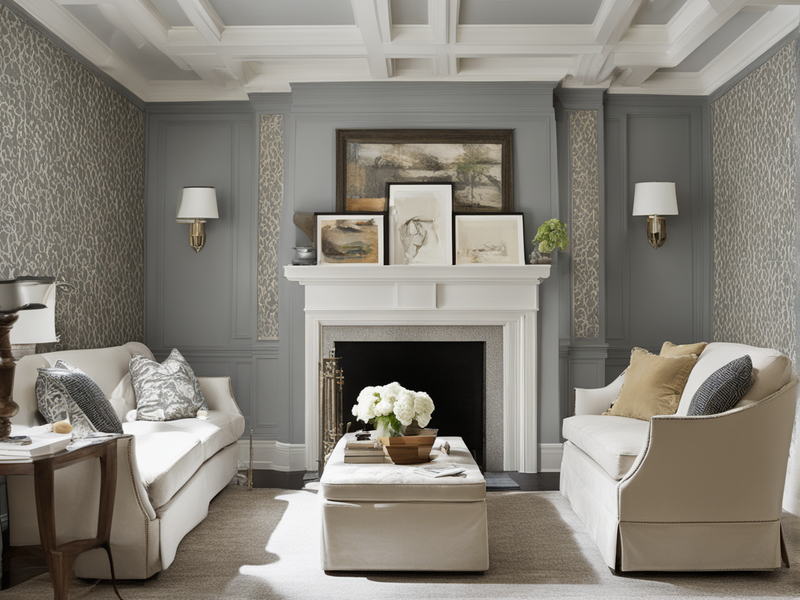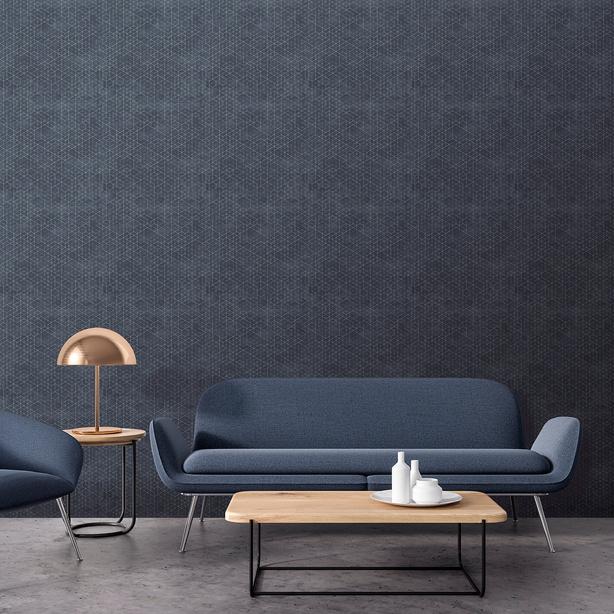The age-old debate between wallcoverings and paint continues to intrigue homeowners and interior designers. Each has its merits, and the choice often boils down to personal preferences, practical considerations, and the desired ambiance. We will explore the advantages and disadvantages of both wallcoverings and paint, helping you make an informed decision for your interior design project.
Pros and Cons of Using Wallcoverings
Aesthetic options and patterns
Wallcoverings provide an extensive range of patterns, textures, and designs that can transform your space. From classic elegance to bold and modern aesthetics, wallcoverings offer a broad spectrum of options.
Durability and easy maintenance
Wallcoverings are exceptionally durable, resisting wear and tear better than paint. They are also easy to clean and maintain, making them a practical choice for busy households.
Concealing imperfections and insulation
Wallcoverings can hide minor imperfections on your walls, creating a smoother appearance. Some even offer insulation benefits, helping regulate temperature and reduce energy costs.
Pros and Cons of Using Paint
Versatility and color choices
Paint provides ultimate versatility in color selection. With virtually endless shades, you can create any atmosphere or match any decor.
Application and touch-ups
Painting is a straightforward process, and touch-ups are relatively simple to perform. It’s an ideal choice for those who enjoy changing their wall color frequently.
Vulnerability and regular maintenance
Painted walls are more vulnerable to scuffs, stains, and chips. They may require more frequent touch-ups and repainting to maintain a fresh look.
Continued in the next table…
Choosing Between Wallcoverings and Paint
Deciding between wallcoverings and paint involves considering several factors:
Factors to consider
- Aesthetic preference: Do you prefer the textures and patterns of wallcoverings, or the simplicity of painted walls?
- Room function: Consider the room’s purpose. For high-traffic areas, durability and easy maintenance might be crucial.
- Cost and budget: Wallcoverings can be more expensive than paint, so consider your budget.
Room-specific recommendations
- Living rooms: Wallcoverings can add elegance and character. Paint can work if you prefer a more minimalist look.
- Bedrooms: Both wallcoverings and paint can be suitable, depending on your desired ambiance.
- Kitchens and bathrooms: Wallcoverings are ideal, as they offer protection against moisture and are easy to clean.
Cost considerations
- Initial cost: Wallcoverings may be more expensive initially due to materials and installation costs.
- Long-term cost: Paint may require more frequent touch-ups and repainting, which can add up over time.
Installation and Maintenance
- Installing wallcoverings: Wallcovering installation can be more complex and may require professional help. Paint application is a more straightforward DIY process.
- Cleaning and maintaining wallcoverings: Wallcoverings are easy to clean but may require special care. Painted walls can be washed, but they may need frequent touch-ups.
- Preparing and painting walls: Paint preparation involves priming and taping. Cleaning and maintaining painted walls are relatively simple but may require repainting over time.
Continued in the next table…
Visual Appeal and Design Versatility
Transforming aesthetics with wallcoverings
Wallcoverings have the unique ability to add depth, texture, and patterns to a room, creating a visually captivating atmosphere.
Color psychology and the power of paint
Paint can influence mood and atmosphere through color psychology. Different paint colors evoke various emotions and have a substantial impact on interior design.
Eco-Friendliness and Sustainability
Sustainability in wallcoverings
Eco-friendly wallcoverings often use recycled or sustainable materials and eco-conscious production processes. These options cater to environmentally conscious consumers.
Eco-friendly paints and their impact
Low-VOC and zero-VOC paints reduce harmful emissions and promote better air quality, making them eco-friendly and suitable for health-conscious individuals.
Application in Residential and Commercial Spaces
Residential use cases
Wallcoverings and paint both have their place in residential spaces, depending on individual preferences and specific room requirements.
Commercial use cases
In commercial settings, wallcoverings can create brand identity and a unique atmosphere, while paint offers a simple, clean look.
Case studies and real-world examples
Explore successful applications of both wallcoverings and paint in various settings through case studies and real-world examples.
Trends in Wallcoverings and Paint
Stay updated with the latest design trends in wallcoverings and paint. We’ll also discuss innovations that are shaping the future of these interior design options.
Conclusion
Choosing between wallcoverings and paint ultimately depends on your preferences, practical considerations, and the desired aesthetic for your space. Each has its unique advantages and drawbacks, allowing you to make an informed choice that suits your specific needs.
Wallpaper vs Paint
“Wallpaper vs. Paint” is a common decision when it comes to interior decorating. Both options have their advantages and disadvantages, and the choice depends on your preferences, budget, and the specific needs of the room. Here’s a comparison of the two:
1. Cost:
- Wallpaper: Wallpaper can be more expensive than paint, especially if you choose high-end or designer options. However, there are affordable wallpaper choices available.
- Paint: Paint is generally more budget-friendly. You can choose from a wide range of paint types and brands to suit your budget.
2. Installation:
- Wallpaper: Installing wallpaper can be more labor-intensive and may require professional help for the best results. It involves precise measurements, pasting, and smoothing to avoid wrinkles or bubbles.
- Paint: Painting is a relatively straightforward DIY project for many people. However, it still requires careful preparation, such as taping off edges and using drop cloths.
3. Variety and Design:
- Wallpaper: Wallpaper offers a vast array of patterns, textures, and designs, allowing you to create a unique and decorative look. It’s an excellent choice for adding visual interest to a room.
- Paint: While paint offers a wide selection of colors, it may lack the intricate patterns and textures that wallpaper can provide.
4. Maintenance and Durability:
- Wallpaper: High-quality wallpaper can be durable and easy to clean, making it a good choice for high-traffic areas. However, it can be damaged by moisture or direct sunlight over time.
- Paint: Paint is easy to touch up, but it may require more frequent repainting in high-traffic areas. It’s also susceptible to scuffs and stains.
5. Removal and Changes:
- Wallpaper: Removing wallpaper can be a time-consuming and sometimes difficult process, potentially damaging the wall underneath. It’s not the best option if you like to frequently change your decor.
- Paint: Repainting is relatively easy and allows for quick color changes without the hassle of removing wallpaper.
6. Style and Atmosphere:
- Wallpaper: Wallpaper can create a cozy, elegant, or dramatic atmosphere, depending on the design. It’s particularly popular for feature walls or statement rooms.
- Paint: Paint is versatile and can create various moods with the right color choices. It’s a great choice for a more minimalist or modern look.
In summary, the choice between wallpaper and paint depends on your budget, design preferences, and how much effort you’re willing to invest. Some people even combine both by using paint and wallpaper in the same room for a unique effect. Ultimately, your decision should align with your aesthetic vision and practical considerations for the space.
FAQs
1. Are wallcoverings easy to remove if I want to change the decor?
Yes, many wallcoverings are removable, though the ease of removal varies based on the adhesive used.
2. Does paint provide insulation like some wallcoverings?
Paint does not offer insulation properties, while some wallcoverings have this advantage.
3. Can I paint over wallcoverings if I change my mind?
In some cases, yes, but proper preparation and primer may be required.
4. Do wallcoverings last longer than paint?
Wallcoverings are generally more durable and may require less frequent maintenance than paint.
5. Are there wallcoverings that mimic the look of paint?
Yes, there are wallcoverings designed to replicate the appearance of painted walls, providing a unique combination of aesthetics and practicality.
The choice between wallcoverings and paint is a matter of personal preference and practical considerations. Consider your specific needs, budget, and design aspirations to make an informed decision that complements your space and suits your style.




